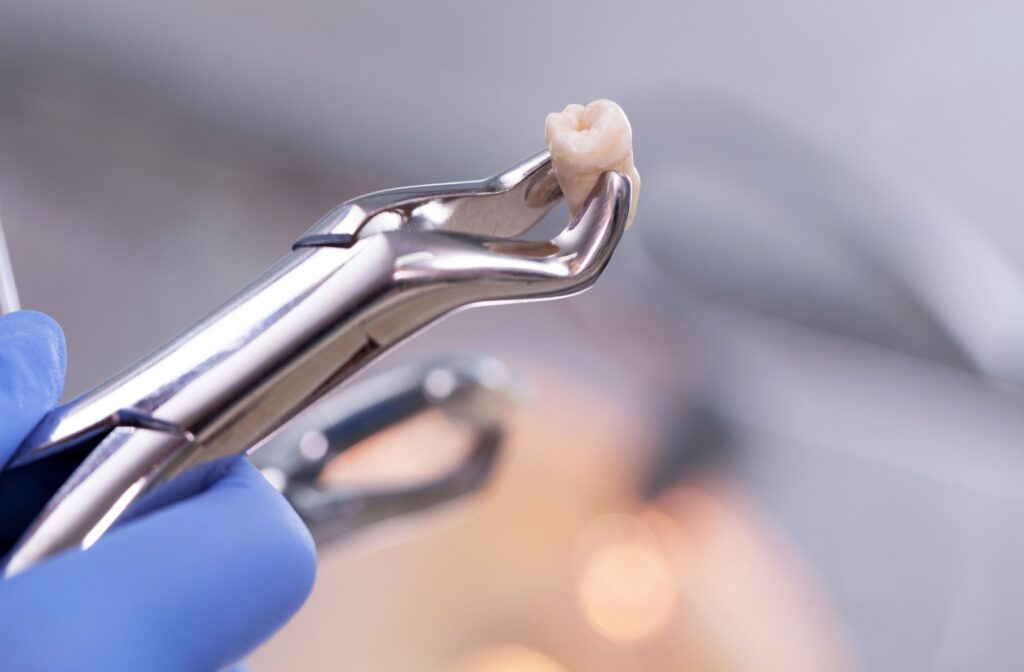
Having a tooth removed is a common dental procedure, and your main focus afterwards should be feeling better as soon as possible. You’ll want to get back to your favourite foods and daily routine without any setbacks.
The good news is that you have a lot of control over how quickly you recover.
Following aftercare instructions is the best way to help your tooth extraction heal faster. Protecting the new blood clot and keeping the extraction area clean are your most important jobs, so you can get back to smiling with confidence.
What to Expect for the First 24 Hours
The first day after your procedure sets the stage for your entire recovery. Your body immediately gets to work forming a blood clot in the empty tooth socket. This clot acts like a natural bandage, protecting the underlying bone and nerves and providing a foundation for new tissue to grow.
Protect the Blood Clot
Your dentist will give you a gauze pad to bite down on after the extraction, with instructions on how long to use it. Keep gentle, firm pressure on this pad for a few hours to help stop any bleeding. This pressure is key to helping a solid clot form and stay in place.
Manage Swelling & Discomfort
Some swelling and tenderness are perfectly normal parts of the healing process. You can use an ice pack on your cheek for 15 minutes at a time to help reduce inflammation. It’s also important to rest and avoid strenuous activity, keeping your head propped up with pillows when you lie down.
Stick To Soft Foods
For the first 24 hours, your diet should be soft and easy to eat. Think yogurt, smoothies, pudding, and lukewarm soup. Avoid anything hot, crunchy, or chewy that could disturb the sensitive area.
Key Steps for a Speedy Recovery
Once you’ve made it through the first day, there are more steps you can take to encourage healing. These simple habits can help you feel more comfortable and may prevent complications. Your body is doing the hard work, but you can certainly help it along.
Does Salt Water Help Heal Tooth Extraction?
Yes, a gentle saltwater rinse is a great way to keep the extraction site clean. Mix half a teaspoon of salt into a glass of warm water and gently swish it around your mouth after meals. When you’re done, just let the water fall out of your mouth into the sink—don’t spit forcefully.
Eat Nutritious Foods
Continue eating soft foods, but try to choose options that are packed with vitamins and minerals. Scrambled eggs, mashed sweet potatoes, and protein shakes give your body the fuel it needs to repair tissue. A healthy diet is essential for supporting your body’s natural healing abilities.
Practise Gentle Oral Hygiene
You can and should brush your other teeth the night of your procedure, just be extremely careful around the extraction site. Avoid brushing the socket or the nearby gums directly for a few days. Maintaining your daily oral hygiene routine for your other teeth helps lower the chances of infection.

What Slows Down Healing After a Tooth Extraction?
Knowing what not to do is just as important as knowing what to do. Some activities can dislodge the blood clot or introduce bacteria to the area. Avoiding these things, which are considered common oral health complications, can help you stay on the right track for a smooth recovery.
Avoid Smoking & Using Straws
The suction from smoking a cigarette or drinking through a straw can easily pull the blood clot out of the socket, and there are many other dental problems associated with smoking that can slow the healing process. It’s best to avoid these activities for at least three to four days after your extraction.
Skip Strenuous Activity
Take a break from the gym and any heavy lifting for a few days. Intense physical activity can raise your blood pressure, which might cause the site to start bleeding again. Give your body the downtime it needs to focus completely on healing.
Watch for Signs of Dry Socket
Dry socket occurs when the blood clot is lost before the socket has had time to heal, leaving the underlying bone and nerves exposed. It requires a follow-up visit to manage the discomfort. Be aware of the signs:
- Significant pain that develops a few days after the procedure
- An unpleasant taste or odour from the empty socket
- Pain that radiates from the socket to your ear
- Visible bone where the clot should be
Understand The Healing Timeline
Every person heals differently, but recovery from a tooth extraction usually follows a general timeline. Knowing what to expect can help reduce any anxiety you might feel about the process. It’s a journey with a few distinct phases.
The First 48 Hours
During the first two days, your main focus is on protecting the clot and managing any swelling. You will likely feel some discomfort and wonder how long the numbness will last, but it should be manageable. Follow the instructions provided by your dental team for the best results.
Why Is Day 3 the Worst After Tooth Extraction?
It’s quite common for swelling and discomfort to peak around the third day. This is a normal part of your body’s inflammatory response and a sign that healing is underway. After this point, you should start to feel a gradual improvement each day.
The First Week & Beyond
Within about a week to ten days, the gum tissue over the socket should be mostly closed. You can usually start reintroducing your normal foods as you feel comfortable. The underlying bone will continue to heal and fill in over the next several months, a process detailed in many guides to extraction recovery.
When to Contact Your Dentist in Lethbridge
While healing usually goes smoothly, it’s important to know when to reach out for advice. Your dental team is here to support you through your recovery. Never hesitate to call if something doesn’t feel right—you can schedule a follow-up with your dentist to provide peace of mind.
Signs You Should Call For Advice
Prompt communication can help address any issues before they become more serious. Please contact our office if you experience any of the symptoms below:
- Bleeding that continues for more than a few hours and doesn’t stop with pressure
- Pain that becomes more severe after the third day
- Signs of infection, such as fever, chills, or pus from the socket
- Nausea or vomiting
Your comfort and health are our top priorities. At Cool Dental, we want to give you more to smile about, and that includes a smooth and speedy recovery. If you have any questions about your tooth extraction aftercare, please contact our team.


